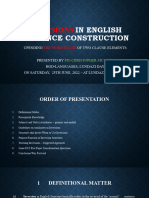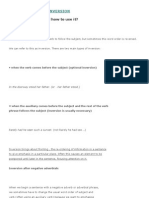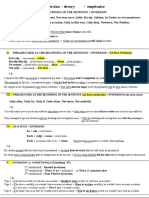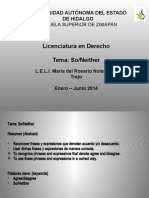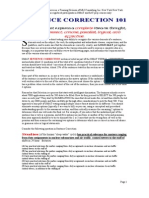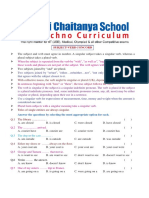INVERSION
April Huang
griu12@outlook.com
626-203-1059
WHAT IS INVERSION?
Usual Statements: Subject + Verb (S. +V.)
Inversion: word order is reversed
Two main types of inversion:
1) subject-auxiliary inversion: the auxiliary comes before the subject
Rarely had he seen such a sunset.
2) subject-verb inversion: the verbs comes before the subject
In the doorway stood her father.
NEGATIVE INVERSION
A type of subject-auxiliary inversion
A sentence begin with a negative adverb
change word order of S. and V. V.+S.
Purpose: to emphasize the adverb
DO-support: add do, does, did if there is no auxiliary
EXAMPLES: BE VERB
He is never happy. Never is he happy.
He is hardly ever quiet. Hardly is he ever quiet.
You are by no means the person we need.
By no means are you the person we need.
He is happy only when Mary is with him.
Only when Mary is with him is he happy.
EXAMPLES: AUXILIARY
He has never done it before.
Never has he done it before.
He can do it under no circumstances. (X)
Under no circumstances can he do this. (O)
Examples: Do-support
He seldom sings. Seldom did he sing.
Only after several weeks did she begin to recover.
Not until I saw him did I remember we had met before.
LOCATIVE INVERSION & DIRECTIVE INVERSION
(INVERSION OF ADVERB PHRASES OF PLACE)
A type of subject-verb inversion
Adverb phrases of place are put first in a sentence, and
subject and verb are inverted adv. phrase+V.+S
Purpose: literary purpose ( in story telling)
EXAMPLE:
A girl sat by the door.
By the door sat a girl.
Mary stood in the doorway.
In the doorway stood Mary.
A man was licked behind the door.
Behind the door was locked a man.
Mary and David were sitting in front of the gate.
Sitting in front of the gate were Mary and David.
In front of the gate were sitting Mary and David.
*IF THE SUBJECT IS A PRONOUN, THERE IS NO INVERSION.
He stood there. There stood he. (X)
There he stood. (O)
Mary comes here.
Here comes Mary. (O)
Here she comes. (O)
Here comes she. (X)
SO & SUCH INVERSION
The usage is the same as negative inversion.
So+ adj. + V.+ S.+ that
Such+ V. +S. + that
Example:
1) he is so helpful that we all like him.
So helpful is he that we all like him.
2) He came so late that he missed the train.
So late did he come that he missed the train.
3) They are such lazy students that they have no hope of
passing the exam.
Such lazy students are they that
ANSWER THE QUESTIONS WITH NEGATIVE INVERSIONS
1) Did you see Lisa make any mistakes? (rarely/ her)
Ans: Rarely have I seen her make any mistake.
2) Does Jack come here to see you very often? (scarcely/ he)
3) Can you understand what the old man says? (hardly/ he)
4) Have you ever been to Asia before? (Never/ I/ there)
5) I Mary always on time? (seldom/ she)
Reword the following sentences
6) The smoke was so dense that they fainted.
So
Invert adverb phrases of place in the sentences
7) A man who held a knife in the hand, looking as if he wanted to
kill somebody, stood there.
8) A boy with a dog which he found the other day sat in the corner.
Reference: Lai P. (2006), English Grammar. Ivy League.
Directions: Everyone has 5 minutes or so to write down
three things about themselves, of which two must be lies.
Have the first student read his/hers, and have everyone
guess which one is true, assigning points for correct
guesses as before. Then go on to the next student, and
proceed until everyone has read their three statements.
To make this game much more interesting, after the
student has read the 3 sentences about him/herself, allow
anyone to ask that person one question. This way, the
student must actually try to lie convincingly, and the game
lives up to its name!
http://www.stickyball.net/games-and-activities.html?id=286

























